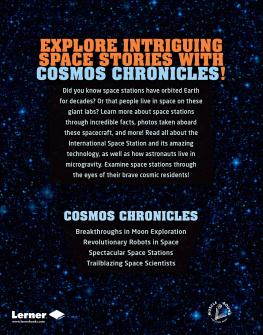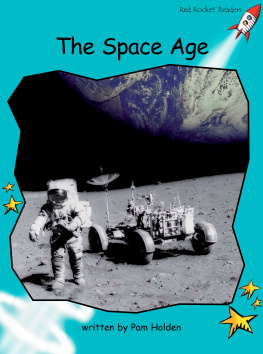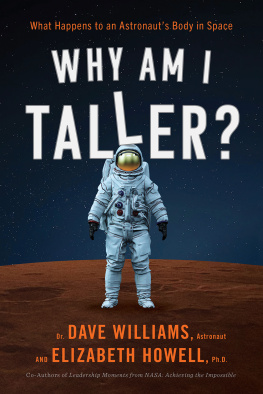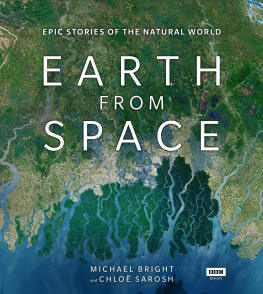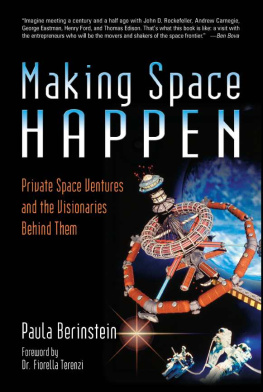
Neil Armstrong practises his small step
For James and Anna
and everyone who enjoys
staring into space
Earth in the viewport
Earth in the viewport that I see
Like a son missing his mother,
Like a son missing his mother,
We miss our Earth we have but one
But the stars nevertheless,
But the stars nevertheless,
Draw closer, though theyre still as cold as ever
And like at the hour of eclipse,
And like at the hour of eclipse,
We wait for light and see our earthly dreams
And we dream not of thunder at the cosmodrome,
Not of the ice-cold blue of the sky
But we dream of grass the grass beside our house
Green, green grass
And we fly our orbits,
Unbeaten paths
Lifetimes like meteors in the vastness
Courage and risk were justified,
For the music of space
Floats into our matter-of-fact talk
In some opaque haze
Earth in the viewport
An early evening-time twilight
But the son misses his mother
But the son misses his mother
The mother waits for her son, as the earth awaits her children
And we dream not of thunder at the Cosmodrome,
Not of the ice-cold blue of the sky
But we dream of grass the grass beside our house
Green, green grass
Zemlyane (Earthlings)
The Grass Beside Our House (1979)
PREFACE
15 DECEMBER 2015
THE BAIKONUR COSMODROME KAZAKHSTAN
45.965 N, 63.305 E
If youve never heard of the Soviet 1980s synth-rock band Zemlyane (Earthlings) and youre thinking about planning a trip to space, it might be worth checking them out. If you happen to be going into space today , its mandatory. The song The Grass Beside Our House is a rousing, hair-sprayed soft-rock anthem thats played to the astronauts as they emerge from the hotel to begin the launch days preparations. You are not allowed to fly on the Soyuz rocket unless that song has been played.
Im standing outside the hotel in a big press scrum in the town of Baikonur, a Russian enclave located by the vast Cosmodrome rocket range in the desert steppe of Kazakhstan. Its from this place, in what was the Soviet Union, that the story of leaving the planet began, on 12 April 1961, when Yuri Gagarin launched from here to orbit once around the earth aboard Vostok 1. Here we are, nearly sixty years later, in the same place, about to watch a launch from the same launch pad on what is essentially the same rocket.
Its early morning and well below freezing. The throng of well-wishers, families, security and press are ready to greet the crew as they emerge. The Grass Beside Our House is playing full blast, distorted through the ancient loudspeakers. I spot a few plastic Union Jacks being waved, and some preemptive shouts of Good luck Tim! The press officer from the European Space Agency (ESA) looks bemused. He hasnt seen anything quite like this before: Why is everyone so excited? Its a very good question.

As Zemlyanes guitar solo builds to its climax, the doors of the hotel open, the cameras spring into action and the three astronauts appear, waving to the cheering crowd, flanked by officials, doctors and the imposing black-robed, bearded Russian priest who yesterday had blessed the Soyuz TMA-19M rocket with holy water in its launch position, pointing towards the heavens. The holy water gives it a little more va-va-voom we journalists joke, congregated together on the launch pad, also receiving a blessing with a generous soaking. Soyuz crews have a long list of superstitious rituals that need to be ticked off: last night they and their families sat down to watch the film White Sun of the Desert . Every astronaut that has flown on Soyuz since 1971 has watched this film the evening before launch. Then theres the planting of the tree, the signing of the door and today, most famously, the peeing on the rear right tyre of the bus that takes the astronauts to the launch pad. Female astronauts, if they wish, can carry a little specimen jar of wee (or they can opt out). Its a bit of a faff otherwise, what with the spacesuit zips and everything. Any parent whos begun a long car journey with kids knows the form. Yuri Gagarin stopped the bus because he (sensibly) just had to go, and if thats what happened on his launch day, thats what happens now.
since the final Apollo 17 expedition to the moon in 1972. Like 1980s rock stars in their mission-patched blue jumpsuits, they make their way through the crowd to board the coach which, disappointingly, is the only non-Soviet era thing around.
In Baikonur it will forever be 1961. Wherever you go around the town there are reminders of its extraordinary place in space history. The local cafe has pictures of every crew who have flown from here; wild Soviet space murals decorate the sides of buildings; half-size mock-ups of Russian rockets line the streets, with statues of the men who built them. Most significant is the bust of Sergei Korolev, the architect of the R-7, the worlds first intercontinental ballistic missile (ICBM), designed to throw a nuclear warhead across the globe onto American soil but, as luck would have it, also really good at throwing satellites, dogs and humans into orbit. Its latest incarnation, the Soyuz launch vehicle, has been the workhorse of human space flight for decades. Since the retirement of the American Space Shuttle in 2011, the Baikonur Cosmodrome is the only bus stop to space for all space-faring nationalities, other than the Chinese who are marching ahead with their own human space programme. And Soyuz, beautiful reliable Soyuz, queen of the skies, is the only vehicle that can get you there.
We are in a transitional period. The broken concrete, rust and peeling paint of the Cosmodrome represent the past and the present. But great changes are afoot. Shiny new spacecraft and launch vehicles are being developed: NASAs unimaginatively named Space Launch System (SLS) promises to get us on the road to Mars. Elon Musks SpaceX is launching spectacular self-landing reusable rockets, and promising commercial trips around the moon all part of his grand plan to propel humans to becoming a multi-planet species. Companies like Blue Origin and Virgin Galactic are opening the doors to sub-orbital roller coaster rides. The moon and Mars are back in the sights of ESA and NASA. The rate of exciting new space announcements is increasing exponentially. For those who have cosmic wanderlust, these promise to be exciting times.
At the launch pad, called Gagarins Start, theres no giant digital display or Thunderbirds -style countdown. Im standing with the various TV crews right up against a rusty barbed-wire fence a little under a kilometre from the launch pad, doing a live link for the BBC. A small stray dog, one of many that live around here, is curled up asleep next to a rusting football goalpost behind me. The dogs that haunt this place have seen all this before of course. There is no advanced warning that the rocket is about to leave you just have to concentrate. The parallel arm of the service gantry pivots eerily away from the rocket as if by telekinesis and a few moments later you hear the hiss of the fuel injectors, followed by a low rumble, exactly like a rumble of thunder, that grows to a deafening roar. Its one of the most beautiful sounds youll ever hear. Like a flower opening, the simplicity of the launch system reveals itself as the rocket becomes weightless, Soyuz is released like a firefly, her flame too bright to look at directly. Three out of 7.3 billion humans are leaving our planet, into the ice-cold blue sky and through to the other side. In a few hours the population of our off-world colony, the International Space Station, will have doubled to six.


